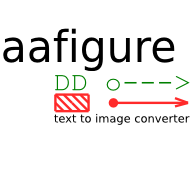Manual¶
Overview¶
The original idea was to parse ASCII art images, embedded in reST documents and output an image. This would mean that simple illustrations could be embedded as ASCII art in the reST source and still look nice when converted to e.g. HTML.
aafigure can be used to write documents that contain drawings in plain text documents and these drawings are converted to appropriate formats for e.g. HTML or PDF versions of the same document.
Since then aafigure also grew into a standalone application providing a command line tool for ASCII art to image conversion.
ASCII Art¶
The term “ASCII Art” describes a wide field.
- (small) drawings found in email signatures
- smilies :-)
- raster images (this was popular to print images on text only printers a few years ago)
- simple diagrams using lines, rectangles, arrows
aafigure aims to parse the last type of diagrams.
Other text to image tools¶
There are of course also a lot of other tools doing text to image conversions of some sort. One of the main differences is typically that other tools use a description language to generate images from rules. This is a major difference to aafigure which aims to convert good looking diagrams/images etc. in text files to better looking images as bitmap or vector graphics. Here are some examples (by no means a complete list):
- Graphviz
Graphviz is a very popular tool that is excellent for displaying graphs and networks. It does this by reading a list of relations between nodes and it automatically finds the best way to place all the nodes in a visually appealing way.
This is quite different from aafigure and both have their strengths. Graphviz is very well suited to document state machines, class hierarchies and other graphs.
- Mscgen
- A tool that is specialized for sequence diagrams (used to describe software, UML).
- ditaa
- Convert diagrams to images.
Installation¶
aafigure¶
This installs a package that can be used from python (import aafigure) and a command line script called aafigure.
The Python Imaging Library (PIL) needs to be installed when support for bitmap formats is desired and it will need ReportLab for PDF output.
To install the module for all users on the system, administrator rights (root) is required..
From source (tar.gz or checkout)¶
Unpack the archive, enter the aafigure-x.y directory and run:
python setup.py install
Setuptools/PyPI¶
Alternatively it can be installed from PyPy, either manually downloading the files and installing as described above or using:
easy_install -U aafigure
Packages¶
There are also packaged versions for some Linux distributions and Windows:
- Ubuntu
Add the repository to /etc/apt/sources.list as described on this page: https://launchpad.net/~aafigure-team/+archive/ppa
Then run apt-get update and apt-get install aafigure
- Arch Linux
- “aafigure” (or “aafigure-bzr”) are found in the category “unsupported”.
- Windows
- For users that have Python already installed, there is an installer for the extension on http://pypi.python.org/pypi/aafigure
Docutils plug-in¶
The docutils-aafigure extension depends on the aafigure package also requires setuptools (often packaged as python-setuptools) and Docutils itself (0.5 or newer) must be installed.
After that, the aafigure directive will be available.
Sphinx plug-in¶
sphinxcontrib-aafig is a plug-in similar to the Docutils plug-in, but it automatically selects the image format depending on the output format.
XXX elaborate
MoinMoin plug-in¶
MoinMoin is a popular Wiki engine. The plug-in allows to use aafigure drawings within wiki pages.
Copy the file aafig.py from examples/moinmoin to wiki/data/plugin/parser of the wiki. The aafigure module itself needs to be installed for the Python version that is used to run MoinMoin (see above for instructions).
Tested with MoinMoin 1.8.
See also: http://moinmo.in/ParserMarket/AaFigure
Usage¶
Command line tool¶
aafigure test.txt -t png -o test.png
The tool can also read from standard in and supports many options. Please look at the command’s help (or man page):
aafigure --help
Within Docutils¶
A aafigure directive is provided that allows to insert images:
.. aafigure::
DD o--->
./rst2html.py README.txt >README.html
This results in the README.html file and a .svg file (or the specified file type) for each aafigure.
The resulting README.html file can be viewed with a SVG capable browser. It has been tested with Firefox 1.5, 2.0 and 3.0.
Within Sphinx¶
In conf.py add:
extensions = ['sphinxcontrib.aafig']
This provides the aafig directive:
.. aafig::
DD o--->
The output format is automatically chosen depending on the generated document format (e.g. HTML or PDF).
Within MoinMoin¶
ASCII Art figures can be inserted into a MoinMoin WikiText page the following way:
{{{#!aafig scale=1.5 foreground=#ff1010
DD o--->
}}}
The parser name is aafig and options are appended, separated with spaces. Options that require a value take that after a = without any whitespace between option and value. Supported options are:
- scale=<float>
- aspect=<float>
- textual
- proportional
- linewidth=<float>
- foreground=#rrggbb
- fill=#rrggbb
There is no background as the SVG backend ignores that. And it is not possible to pass generic options.
The images are generated and stored in MoinMoin’s internal cache. So there is no mess with attached files on the page. Each change on an image generates a new cache entry so the cache may grow over time. However the files can be deleted with no problem as they can be rebuilt when the page is viewed again (the old files are not automatically deleted as they are still used when older revision of a page is displayed).
